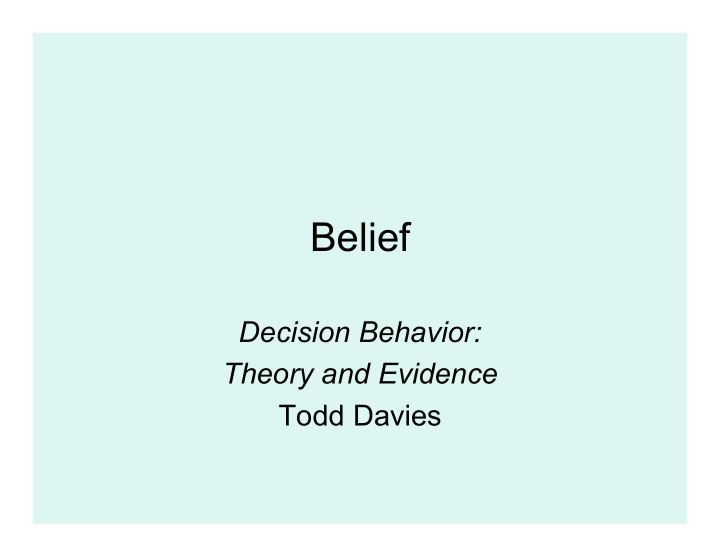



Belief Decision Behavior: Theory and Evidence Todd Davies
Belief Concepts • Proposition • Truth value • Believing a proposition • Asserting a proposition • Veridical beliefs
A Normative Model for Belief • Beliefs should be veridical. • Beliefs should be true when the truth is available in the agent’s environment or context. • Beliefs should not be false when the truth is available.
Descriptive Model: Are people’s beliefs veridical? • Beliefs about motion • Do false beliefs about motion matter? – “An acquaintance of ours was recently stepping onto a ladder from a roof out from under him. As he began to fall, he pushed himself out from the edge of the roof in an attempt to land in a bush about 3 feet out from the base of the house. … However, he overshot thebush, landing about 12 feet from the base of the house and breaking his arm. Was this just a random miscalculation, or did our acquaintance push off too hard because of a naïve belief that he would move outward for a short time and then fall straight down?” McCloskey, 1983, quoted in Baron, 2000
See more visual illusions at http://eluzions.com/Pictures/Ill usions/
What about cases like this? Published on Tuesday, July 1, 2003 by the Associated Press Poll Says Most Americans Believe Saddam-9/11 Link Has Been Proven WASHINGTON - Seven in 10 people in a poll say the Bush administration implied that Iraq and its leader Saddam Hussein were involved in the Sept. 11 attacks against the United States. And a majority, 52 percent, say they believe the United States has found clear evidence in Iraq that Saddam was working closely with the al-Qaida terrorist organization .
Logic • Propositional logic • Categorical (syllogistic) logic • Predicate (first order) logic • Second order, multivalued, inductive logics etc.
Syllogisms • All A are B, All B are C, Therefore All A are C – Conclusion is correct – Most people get this right • Some B are A, all B are C, Therefore Some A are C – Conclusion is correct – Many more people get this wrong than when terms are reversed in first premise - figural effect • No A are B, All B are C, Therefore No A are C – Conclusion is incorrect; explanation - multiple models
Belief bias (Evans et al.) Category Example Acceptance rate No police dogs are vicious Valid-believable 89% Some highly trained dogs are vicious Therefore, some highly trained dogs are not police dogs No nutritional things are inexpensive Valid-unbelievable 56% Some vitamin tablets are inexpensive Therefore, some vitamin tablets are not nutritional No addictive things are inexpensive Invalid-believable 71% Some cigarettes are inexpensive Therefore, some addictive things are not cigarettes Invalid-unbelievable No millionaires are hard workers 10% Some rich people are hard workers Therefore, some millionaires are not rich people
Belief overkill “People who favored a nuclear test-ban believed that testing created a serious medical danger, would not lead to major weapons improvements, and was a source of international tension. Those who opposed the treaty usually took the opposite position on all three issues.... choices are easier since all considerations are seen as pointing to the same conclusion. Nothing has to be sacrificed. But, since the real world is not as benign as these perceptions, values are indeed sacrificed.” (Jervis, 1976, pp. 129- 130)
Believing the consquential closure of one’s beliefs • Normative principle: If A believes X and A believes that X implies Y, A should believe Y • Does this hold descriptively?
Recommend
More recommend